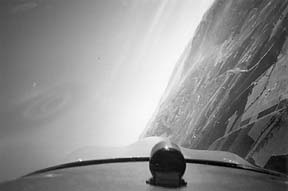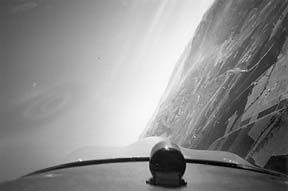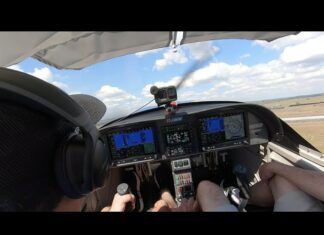
Remember that pilot personality self-survey, with the half dozen psycho babble attitudes guaranteed to make a smoking hole? There was resigned, anti-authority, impulsive, macho and invulnerable.
We think a more accurate way to assess whether a pilot falls into one of these groups is to connect him to an EEG and see which button lights up following the words, Caution wake turbulence, departing 757.
Would your button be Resigned? Impulsive? Invulnerable? If you don’t spend your spare time tearing up gyros for fun, the prospect of an uncommanded flight upset might make your blood run cold.
A better-than-average grasp of airmanship may cause you to understand that the instinct to pull away from trouble can get you killed. But the absence of practical training may we’ll relegate that understanding to the cognitive waste bin when you really do wind up inverted. Toward that end, we set out to find some solid courses of instruction in the sorts of emergencies and upsets the average GA Joe might encounter in the real world. We werent interested in aerobatic courses masquerading as emergency training but courses aimed sharply at surviving upsets and loss of control.
West Coast Visit
The most comprehensive offering of the sort we wanted was Rich Stowells Emergency Maneuver Training Program, operating from CP Aviation at Santa Paula, California.
Not only has Stowell authored a comprehensive book and a video on the subject, but this was also the only course we found that included specific training on dealing with control surface failures and off-airport landings, just the sorts of things GA pilots are likely to encounter.
Stowell graduated from Rensselaer in 1980 with a B.S. in mechanical engineering. Dutiful entry into the real world followed but the lure of flight beckoned. He has taught aerobatics and emergency procedures for more than a decade.
Nevertheless, its apparent that he still feels enthusiasm for both the subject and the students. He has authored a comprehensive book on Emergency Procedures ($29.95) as we’ll as a video ($69.95, $15 less with the book). We found these very useful, both as an advance introduction to the flight training and an after-the-fact means of review that wasnt dependent on adrenaline-impaired recollection.
Down time around Santa Paula really isn’t, by the way, so you shouldnt hesitate to team up with a friend for the EMT course. Youll enjoy waiting for the other student, as the Santa Paula Airport is Hangar Rat Heaven, boasting a wealth of exotic aircraft in daily operation as we’ll as an on-field restaurant we’ll equipped with outside tables facing the runway.
Two Modules
The EMT program has two distinct modules of interest for our purposes. The first consists of four lessons on stall/spin awareness, which is a prerequisite for the second module on general in-flight emergencies. (There’s also a third module on basic aerobatics.)
Each module is composed of roughly three hours ground and three hours flight time, broken up over two days. In other words, it takes four days to complete both modules in the same visit. Combined cost for both is $1065 per person, using both the Citabria and Decathlon. If you attend with a friend, ground school can be combined and the cost adjusted accordingly.
If you happen to own an aircraft appropriate to the training offered, that can be factored in, too. There’s one flight in the morning and one in the afternoon. Each is preceded with a ground school and briefing.
Except in cases of extreme insomnia, aerodynamics has never been our favorite bedtime reading. Maybe we just werent paying attention, but several aspects of Stowells presentation gave us comprehension of elements which had been largely rote response before the course or the training cast things in a truly useful light for the first time.
All this will be old hat to the closet aeronautical engineers, aerobatic types and other assorted greybeards, of course, but this was the first time we began to grasp in a useful way the relationship between center of gravity and center of pressure and what it does to pitch moments, for example.
Stowell also disposed of the old pitch or power as altitude control argument once and for all, converting it instead into an intuitive understanding of kinetic vs. potential energy, something fighter pilots who wish to live to old age learn but GA pilots don’t.
Pop quiz: What control surface is the primary turn mechanism? If you said aileron, youre in well-populated but incorrect company. Its actually the elevator, for reasons that Stowells textbook and flight training make clear and accessible.
Stalls: Deep Understanding
Probably the single most parroted but least intuitive element of the aviation catechism for the average GA pilot is that an airplane can stall in any attitude at any airspeed. Now we understand that wisdom.
For the typical GA pilot, breaking the pitch-equals-up-and-down and airspeed-equals stall syndrome is one of the more useful aspects of this sort of instruction.
Another bit of knowledge we hadnt assimilated previously concerned wing tip vortices. Stowells materials explain the traditional aspects, of course, but also notes that there’s downwash area between thevortices, which makes sense when you think about it. According to the EMT materials, this central mini-downburst can exceed 1000 FPM, which explains why weve had that sinking feeling on occasion taking off behind a heavy aircraft, despite no apparent roll component.
Stowell also explains that wing tip vortices generated in ground effect have been observed to bounce as high as twice the wing span of the generating aircraft. So much for always being safe when above the other airplanes flight path. As a matter of context, both individuals attending during the four days we were at Stowells school were fairly typical Part 91 weekend wonders with zero aerobatic or tailwheel time.
Module I, stall/spin awareness, began with general familiarization with the Citabria and a standard coordination series, including Dutch rolls, slow flight and a full stall series. (By the way, students do the takeoffs and landings, in addition to the air work. Its not a tailwheel checkout, of course, but all landings are power off/engine out procedures and you get some nice hands-on tailwheel experience.)
The emphasis is on kinesthetic detection of the stall, which is enhanced by the significantly greater adverse yaw and overbank tendency endemic to these aircraft. The exercises progress from the typical formula to power-off and power-on stalls looking out at the wing tip or even overhead rather than over the nose.
Contrary to most primary flight instruction, the objective is to recover just enough to break the stall. No power allowed and precious little forward elevator, as opposed to the major power dives commonly found in primary stall training. The first flight concludes (after .8 that feels like 8.0) with hands-off rudder stalls, walking the airplane away from any fall off.
Spins, Too
The afternoon of the first day was devoted entirely to power off spins. Stowell is remarkably patient with the run-of-the-ramp spam canners oh, nooooooo reaction (including one attendee who was mildly acrophobic), calmly reiterating the pre-maneuver advice that evaporated as soon as the nose broke for the ground.
And the student calls the tune as to what occurs when and how often. If your gastric gyros start to tumble, no problem. Whats amazing is to realize that when youre finished with this introduction to spins, the half dozen or so youve done are roughly three times as many as most CFIs have under their belts.
Depending on student interest and needs, the standard curriculum may be rearranged a bit. Our second day reversed lessons three and four, ending up with the Decathlon. The morning lesson included arrestingincipient spin entries, skidded turns to the spin (the typical inadvertent scenario) and botched spirals.
Each procedure went farther than we had experienced previously. For example, incipient spin entry proceeded until Stowell specifically called for the recovery, which was roughly 30 degrees into the fall off. It was illuminating just how hideously wrong the badly skidded turn feels we’ll before the actual snap into the spin.
Stowells spirals are the graveyard variety not the commercial test/constant airspeed sort. Once again, actual experience is substantially more useful than all the text descriptions you could ever read.
The second afternoon continued with more spins, included aggravated spin modes and unusual attitude spin recoveries. In order to demonstrate the absolute necessity for correct inputs in the correct order, Stowell initiates normal spin entries which he then aggravates with the wrong input, the first by adding power, then aileron, then elevator.
In each instance, a relatively docile spin transitions quickly into a distinctly more intense experience, which constitutes superlative reinforcement for doing PARETM – power off, aileron neutral, rudder full opposite and elevator forward as needed, affirmatively and in the correct order.
The lesson finishes up with several exercises in which Stowell initiates a spin from a variety of unusual attitudes and then turns it over to the student to recover, requiring recitation of the correct input prior to actuation. Of course, in our case, power, aileron, rudder became power, aileron, whoa!, which is not in the syllabus we were working with.
Flexibility
Module II was also rearranged a bit for us. The first morning was devoted almost entirely to slips and slipping turns. Ho-hum? If you were trained as we were during slip instruction, you were told to avoid a slipping stall at all costs if you wished to live to a ripe old age.
Not true, as Stowell demonstrates beyond equivocation. Its coupled or skidded control inputs which excite a spin. Slipping stalls in the Citabria resulted in a thoroughly benign, straight-ahead bobbing motion. You can simulate the same flight condition in more mundane GA aircraft by restricting rudder travel. The nose will turn some, but it remains a gentle and easily correctable procedure.
The afternoon of the third day became a bit more exciting once again, moving on to aileron rolls, which are basically Dutch rolls that don’t know when to give up. Once the student is competent in that mode, the roll is halted at inverted, held briefly and then completed.
None of this is for purposes of turning out the next Sean Tucker, however. The point is to introduce the student to the feel, sight picture and correct response to an inadvertent roll encountered in wake turbulence or similar upset.
Its also instructive when the G-meter is consulted after the flight. Properly executed (or even close), the needles remain we’ll within the envelope of normal or utility aircraft. In other words, you have done nothing from which the average Piper or Cessna cant recover intact.
Control Failure Training
The fourth and final day began with ground and flight instruction on control surface failures. Initially, Stowell would call the failure in a turn, requiring the student to make the correct compensation. For example, the aileron has failed locked left, so right rudder is required to initiate a controlled slip tracking a heading.
This progresses to unannounced failures in a turn and its up to the student to diagnose what has failed and initiate the correct response prior to 30 degrees of bank.
Management of elevator failure is explored next. And in case youre interested, this failure is not especially uncommon in light aircraft, the recent Alaska Airlines MD80 crash notwithstanding. Several departures stalls with a full-up and locked elevator are dealt with promptly but easily with power reductions and appropriate rudder inputs.
Stowell even demonstrates the turn capabilities of an open door, although this is something you should explore in your own aircraft as the results are reversed depending on whether the door is fore or aft of the CG.
Attention then progresses to off airport landings, including discussion of a variety of visual cues we hadnt heard elsewhere. Speed, Spot and Set-up are the drumbeats, with continuous judgment and adjustment emphasized throughout.
You Can Handle It
Our course ended with a variety of coordination exercises, including additional akro turns isolating the aileron and elevator inputs with Dutch rolls during turns for good measure. Stowell then returns to rolls and roll recoveries, requiring the student to recover promptly andaccurately from several different roll upsets, including over the top. Roll recovery practice concludes with several low-speed in-the-pattern type recoveries (at altitude) from roll upset.
After this training, the words caution, wake turbulence need provoke neither impulsiveness, resignation nor machismo. Old wives tales are destroyed and effective responses to various emergencies are ingrained.
A truly extreme attitude encountered for the first time alone can reduce a normally capable PIC into a glorified left seat passenger along for the brief but terrified ride. Its we’ll worth considering a program like this against the day when the airplane rolls on its back or an elevator cable snaps, so you can truly remain the pilot in command.
Address
Rich Stowell
Aviation Learning Center
P.O. Box 4597
Ventura, CA 93007
800-869-6627
FAX: 805-525-0877
www.west.net/~rstowell
e-mail: [email protected]
Also With This Article
Click here to view the Training Checklist.
Click here to view “Other EMT and Aerobatic Options.”
-by Jane Garvey
Jane Garvey is a contributing editor to Aviation Consumer. She bases her Cessna 182 near Raleigh, North Carolina.


